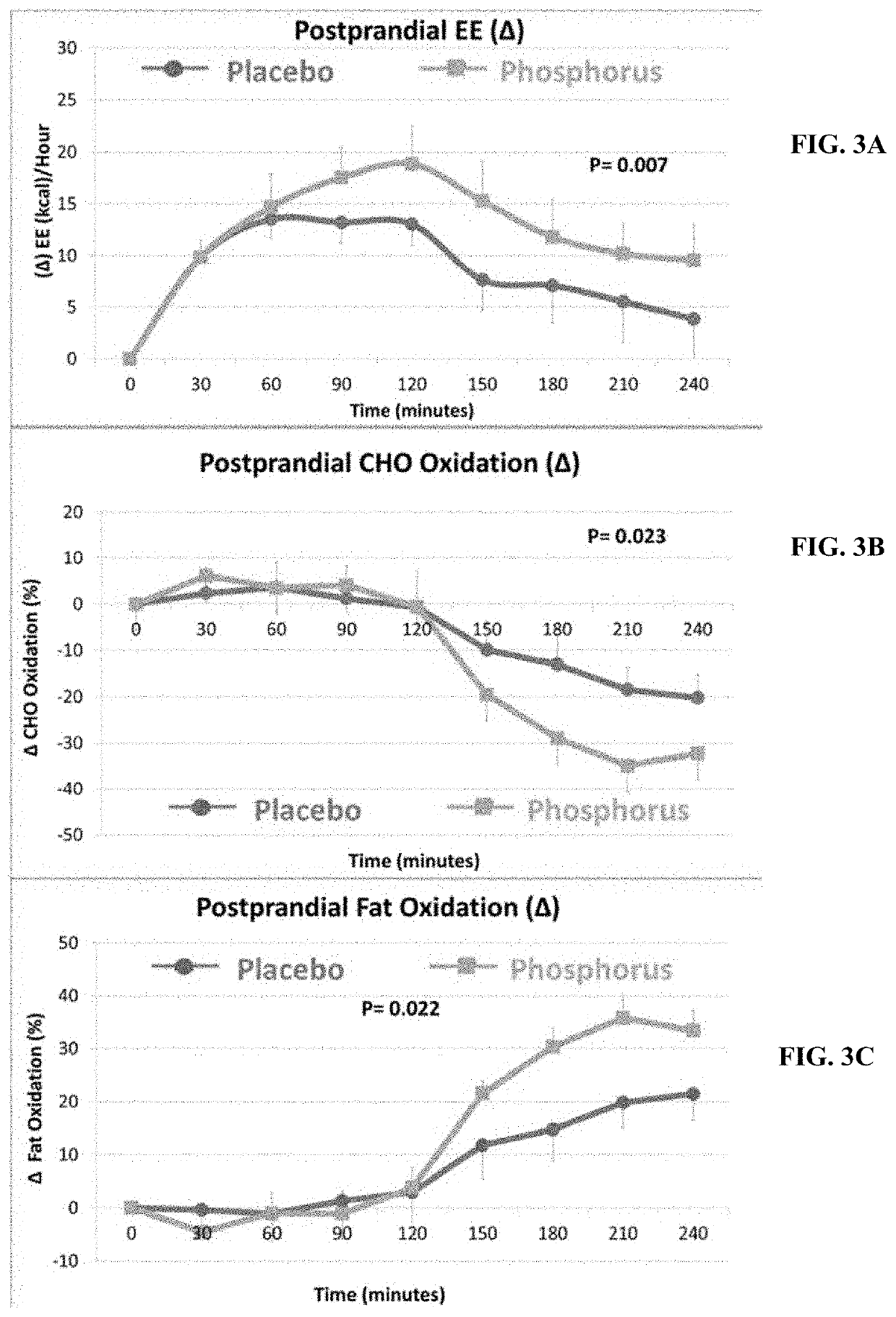Composition and use of macro-minerals to lower postprandial glycemic response and reduce body weight
a macro-mineral and postprandial glycemic technology, applied in the field of bread products, can solve problems such as the imbalance between energy intake and expenditure, and achieve the effects of reducing waist circumference, increasing energy expenditure, and preventing weight gain
- Summary
- Abstract
- Description
- Claims
- Application Information
AI Technical Summary
Benefits of technology
Problems solved by technology
Method used
Image
Examples
example 1
s Ingestion Improves Oral Glucose Tolerance of Healthy Male Subjects
[0074]The example was comprised of two experiments. Healthy male subjects were recruited to perform the experiments (Table 1). Placebo (cellulose) or P (125 mg of potassium phosphate per tablet) tablets, which had similar weight and color, were administered to subjects in a randomized order to prevent order-of-treatment effect. The consent forms were obtained from patients.
TABLE 1Characteristics of the study subjectsCharacteristicsMean ± SEMExperiment 1 (n = 7)Age (years)23.22 ± 1.83Weight (kg)68.88 ± 4.05Height (m) 1.74 ± 0.02BMT (kg / m2)22.65 ± 0.82Fasting glucose (mg / dl)86.38 ± 1.62Fasting triglycerides (mg / dl)90.63 ± 15.9Fasting phosphorus (mg / dl) 4.06 ± 0.19Experiment 2 (n = 8)Age (years) 27.3 ± 1.68Weight (kg) 73 ± 4.78Height (m) 1.76 ± 0.04BMT (kg / m2) 23.5 ± 0.97Fasting glucose (mg / dl) 88 ± 2.17Fasting triglycerides (mg / dl) 119 ± 15.3Fasting phosphorus (mg / dl)3.75 ± 0.2
Experiment 1: The Effect of Phosphorus...
example 2
Phosphorus Content of Preload Suppresses Ad Libitum Energy Intake at Subsequent Meal
[0095]A preliminary set of experiments was conducted to investigate the effect of increased phosphorus content of a preload solution on subsequent food intake. The effect of water, sucrose (50 g), fructose (40 g fructose plus 10 g glucose) or glucose (50 g) preloads was examined with or without the addition of 500 mg of phosphorus (mixture of potassium and sodium phosphate). This work was approved by the Institutional Review Board of the American University of Beirut and written informed consent was obtained from all subjects. In brief, participants who had stable body weight for the last 3 months and were unrest-rained eaters as assessed by the three-factor eating questionnaire were selected. All subjects were regular breakfast consumers and were asked to maintain their regular dietary and physical activity habits throughout the course of the example. Subjects were asked to avoid alcohol consumption...
example 3
Postprandial Energy Expenditure Following the Addition of Phosphorus to a High Carbohydrate Meal
[0102]The objective was to determine the effect of phosphorus (P) ingestion with high carbohydrate meal on postprandial energy expenditure. P ingestion increases postprandial thermogenesis of the subjects.
[0103]A cross over study was conducted on six lean male subjects. Subjects received a 500 Kcal high carbohydrate meal (CHO: 65% E; Fat: 31% E; Protein: 4% E) with (500 mg of P) or without P. Energy expenditure was measured at baseline and at 30 minute intervals for 4 hours following meal ingestion using a ventilated hood and canopy system COSMED QUARK CPET unit.
[0104]FIGS. 3A-3C shows the postprandial energy expenditure of meal containing P was significantly higher than that of placebo (p=0.007). This increase was associated with a significant rise in fat oxidation (%) (p=0.022), while carbohydrate oxidation (%) was decreased (p=0.023).
[0105]P was able to increase postprandial energy exp...
PUM
 Login to View More
Login to View More Abstract
Description
Claims
Application Information
 Login to View More
Login to View More - R&D
- Intellectual Property
- Life Sciences
- Materials
- Tech Scout
- Unparalleled Data Quality
- Higher Quality Content
- 60% Fewer Hallucinations
Browse by: Latest US Patents, China's latest patents, Technical Efficacy Thesaurus, Application Domain, Technology Topic, Popular Technical Reports.
© 2025 PatSnap. All rights reserved.Legal|Privacy policy|Modern Slavery Act Transparency Statement|Sitemap|About US| Contact US: help@patsnap.com



